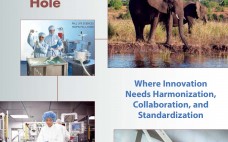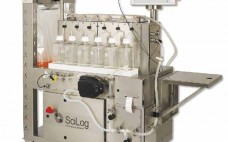Single-use systems (SUS) consist of numerous plastic components derived from different suppliers. As such, they are prone to changes, including alterations in construction materials or modifications in manufacturing processes. Such changes may originate at the immediate supplier or farther back in the supply chain as a result of product improvements, process improvements, part discontinuation, or even business decisions such as manufacturing site relocation. Whether those changes are major or minor, managing their impact on biopharmaceutial processes and product quality often…
Risk Management
Manufacturing Strategies: BPI Theater @ Interphex 2015
Bill Hartzel (director of strategic execution for advanced delivery technologies, Catalent Pharma) 1:30–1:55 pm Reducing the Risk Associated with the Filling of Biologics with Advanced Aseptic Processing Hartzel discussed leveraging “blow–fill–seal” (BFS) aseptic processing technology to reduce risks associated with biologics fill and finish. A number of drug recalls have been associated with microbial and particulate contamination of glass vials, problems that could be solved using BFS. Automation eliminates human intervention at this critical stage, driving out associated risks. Hartzel…
Challenges in Implementing Quality By Design: An Industry Perspective
In the fall of 2004, the US Food and Drug Administration (FDA) published a final report entitled Pharmaceutical CGMPs for the 21st Century: A Risk-Based Approach (1). This publication set the groundwork for a prospective risk‑based approach to pharmaceutical product development. It was published on the heels of a November 2003 agreement between the FDA and the International Conference on Harmonisation of Technical Requirements for Registration of Pharmaceuticals for Human Use (ICH) to develop an internationally harmonized plan for developing…
Fundamental Strategies for Viral Clearance Part 2: Technical Approaches
Viral safety is required for biologics manufactured to treat human diseases. Although significant improvements in ensuring viral safety have been made over the past few decades, “zero risk” of viral contamination is a myth. Viral contamination risk can be carefully managed by screening raw materials, testing process intermediates, and evaluating how effectively manufacturing processes remove and inactivate viruses. Viral clearance studies verify virus removal or inactivation by a manufacturing process. Although regulatory agencies have expectations for the designs of those…
Modern Technology Transfer Strategies for Biopharmaceutical Companies
Application of industrial biotechnology has changed dramatically over the past decade. Stainless steel process equipment has largely given way to disposable systems, facilitating easier and quicker process configurations and up-scaling. Suppliers generally made incremental advances in the quality of raw materials and consumables to ensure that those could more readily comply, “off the shelf,” with regulatory expectations. Once out-of-reach analytical equipment such as mass spectrometers and cell analyzers are becoming more common place in development laboratories, which better enables biopharmaceutical…
A Quick Guide for Sourcing Biopharmaceutical Raw Materials
Before the ratification of regulatory guidelines from The International Conference on Harmonisation of Technical Requirements for Registration of Pharmaceuticals for Human Use (ICH) Q8–Q11 (1–4) — whose scope includes raw materials for biopharmaceutical production — many drug manufacturers chose the most cost-effective and readily available raw materials sourcing options without specifically considering the provenance of those materials. Depending on the chosen supply chain, such materials could be of widely varying quality and not necessarily suitable for a destined application. Raw-material…
The Single-Use Watering Hole: Where Innovation Needs Harmonization, Collaboration, and Standardization
Within the past few years, the single-use technology (SUT) arena of the biopharmaceutical industry has exploded in growth. Leading organizations have predictably and understandably stampeded to the “watering hole” of single-use to drink up the advantages that disposable components offer over traditional multiuse parts and technologies. The initial value and risk-reduction results are being realized — but not without the emergence of other trade-offs. End users continue to call for standardization in emerging areas of the industry while also recognizing…
The CMC Strategy Forum Series, Part 1 – QbD and Risk Management
Introduction by Cheryl Scott The CMC Strategy Forum series provides a venue for biopharmaceutical product discussion. The meetings focus on relevant chemistry, manufacturing, and controls (CMC) issues throughout the life cycle of a therapeutic and thereby foster collaborative technical and regulatory interaction. Forum chairs share information with regulatory agencies to help them merge good scientific and regulatory practices. Outcomes of the forum meetings are published in BioProcess International. This process is meant to help ensure that biopharmaceutical products manufactured with…
Exploring Options for Dual Sourcing of Single-Use Components
As the bioprocess industry progressively adopts single-use technologies for large-scale manufacturing (1, 2), biomanufacturers’ increased reliance on integrators for critical production equipment continues to raise concerns about supply chain security. The need to mitigate risks associated with the supply of single-use components (e.g., bioreactors, aseptic connectors, tubing, filters) has led to growing interest in the dual sourcing of those materials. To that end, integrators and end users alike are exploring the definition of functionally equivalent products, how functional equivalency can…
Understanding and Controlling Sources of Process Variation: Risks to Achieving Product Critical Quality Attributes
Biopharmaceuticals include recombinant proteins, vaccines, gene therapies, and drug products derived from stem cell technology. One key characteristic of shared by all biologics is that they tend to be extremely large molecules with complex three-dimensional structures, critical to their functionality. For example, monoclonal antibodies (MAbs) are composed of more than one thousand times larger than a molecule of aspirin (one analogy compares the complexity of a MAb to that of an F16 jet, and the complexity of aspirin to that…








